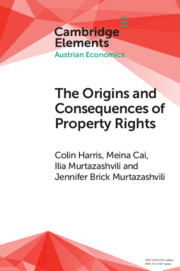Element contents
The Origins and Consequences of Property Rights
Published online by Cambridge University Press: 30 November 2020
Summary
Keywords
Information
- Type
- Element
- Information
- Series: Elements in Austrian EconomicsOnline ISBN: 9781108979122Publisher: Cambridge University PressPrint publication: 24 December 2020
References
Accessibility standard: Unknown
Why this information is here
This section outlines the accessibility features of this content - including support for screen readers, full keyboard navigation and high-contrast display options. This may not be relevant for you.Accessibility Information
- 15
- Cited by
